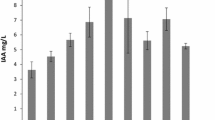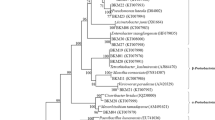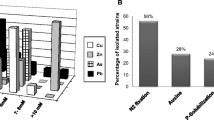Abstract
Rhizobacteria with properties related to plant growth-promotion were isolated from the rhizosphere of the perennial legume Chamaecytisus proliferus ssp. proliferus var. palmensis (tagasaste) growing in field conditions. Samples were collected in two localities of the Tenerife Island: La Laguna and El Tanque, NE and NW at 600 and 1000 meters above sea level, respectively, and in two seasons, winter and summer. The strains were isolated by using culture dependent procedures, and identified by phenotypic (culturable and biochemical) and genotypic (ERIC-PCR fingerprinting) features. The rhizosphere isolates formed a diverse community of mainly Gram-negative bacteria, with members of genera Pseudomonas, Burkholderia and Sphingomonas being predominant. A high level of selectivity was found in the rhizosphere environment as compared to the non-rhizosphere soil where Gram-positives were more abundant. Species richness (number of species) and species abundance were related to the sampling season and the locality, thus, samples obtained in winter at both sites had larger counts than samples obtained in summer, and the higher species richness was found in La Laguna. The species Pseudomonas fluorescens showed the highest number of properties related to plant growth promotion (PGP): 1-aminocyclopropane-1-carboxylate (ACC) deaminase activity, phytohormone production, nitrogen fixation, fungal growth inhibition and cyanogenesis, thus it seems to be the most suitable microorganism to be tested in PGP-field experiments.
Similar content being viewed by others
References
Abadi Ghadim A K 2000 Water repellency: A whole-farm bioeconomic perspective. J. Hydrol. 231, 396–405.
Acebes-Ginovés J R, del Arco-Aguilar M and Wilpret de la Torre W 1991 Revisión taxonómica de Chamaecytisus proliferus (L. fil.) Link en Canarias. Vieraea 20, 191–202.
Amann R L, Ludwig W and Schleifer K 1995 Phylogenetic and in situ detection of individual microbial cells without cultivation. Microbiol. Rev. 59, 143–169.
Ausubel F M, Brent R, Kingston R E, Moore D D, Smit J A, Seidman J C and Struhl K S 1990 Current Protocols in Molecular Biology. John Wiley, Inc. New York.
Azcón-Bieto J and Talón M 1993 Fisiología y Bioquímica Vegetal. Ed. Mc Graw-Hill. Interamericana de España., Madrid, Spain. 346 pp.
Balandreau J, Viallard V, Cournoyer B, Coenye T, Laevens S and Vandamme P 2001 Burkholderia cepacia genomovar III is a common plant-associated bacterium. Appl. Environ. Microbiol. 67, 982–985.
Cattelan A J, Hartel P G and Fuhrmann J J 1999 Screening for plant growth-promoting rhizobacteria to promote early soybean growth. Soil Sci. Soc. Am. J. 63, 1670–1680.
Cleland R E 1990 Auxin and cell elongation. In Plant hormones and their role in plant growth and development. Ed. P J Davies. pp. 132–148. Kluwer Academic Publishers, Dordrecht, The Netherlands.
de Brito-Álvarez M A, Gagné S and Antoun H 1995 Effect of compost on rhizosphere microflora of the tomato and on the incidence of plant growth-promoting rhizobacteria. Appl. Environ. Microbiol. 61, 194–199.
del Arco M, Acebes J R, Pérez de Paz P L and Marrero M C 1999 Bioclimatology and climatophilus vegetation of El Hierro (Part 2) and La Palma (Canary Islands). Phytocoenologia 29, 253–290.
Döbereiner J 1995a Isolation and identification of aerobic nitrogen-fixing bacteria from soils and plants. Methods in Applied Soil Microbiology and Biochemistry. Eds. K Alef and P Nannipieri. pp. 134–137. Academic Press, London, San Diego, New York, Boston, Sydney, Tokyo, Toronto.
Döbereiner J 1995b Isolation and identification of aerobic nitrogen-fixing bacteria from soils and plants. In Methods in Applied Soil Microbiology and Biochemistry. Eds. K Alef and P Nannipieri. pp. 137–139. Academic Press, London, San Diego, New York, Boston, Sydney, Tokyo, Toronto.
Dunbar J, Ticknor L O and Kuske C R 2000 Assessment of microbial diversity in four southwestern United States soils by 16S rRNA gene terminal restriction fragment analysis. Appl. Environ. Microbiol. 66, 2943–2950.
Dunne C, Crowley J J, Moënne-Loccoz Y, Dowling D N, de Bruijn F J and O’Gara F 1997 Biological control of Pythium ultimum by Stenotrophomonas maltophilia W81 mediated by an extracellular proteolytic activity. Microbiology 143, 3921–3931.
Dworkin M and Foster J 1958 Experiments with some microorganisms which utilize ethane and hydrogen. J. Bacteriol. 75, 592–601.
Elo S, Maunuksela L, Salkinoja-Salonen M, Smolander A and Haahtela K 2000 Humus bacteria of Norway spruce stands: plant growth promoting properties and birch, red fescue and alder colonizing capacity. FEMS Microbiol. Ecol. 2000, 143–152.
Esashi Y 1991 Ethylene and seed germination. In The plant hormone ethylene. Eds. A K Matto and J C Suttle. pp. 133–157. CRC Press, Inc., Boca Raton, Fla.
Estrada-de los Santos P, Bustillos-Cristales R and Caballero-Mellado J 2001 Burkholderia, a genus rich in plant-associated nitrogen fixers with wide environmental and geographic distribution. Appl. Environ. Microbiol. 67, 2790–2798.
Fåhraeus G 1957 The infection of clover root hairs by nodule bacteria studied by a simple slide technique. J. Gen. Microbiol. 16, 379–381.
Francisco-Ortega J, Newbury H J and Ford-Lloyd B V 1993 Numerical analyses of RAPD data highlight the origin of cultivated tagasaste (Chamaecytisus proliferus ssp. palmensis) in the Canary Islands. Theor. Appl. Genet. 87, 264–270.
Genrich I B, Dixon D G and Glick B R 1998 A plant growth-promoting bacterium that decreases nickel toxicity in seedlings. Appl. Environ. Microbiol. 64, 3663–3668.
Glick B R, Karaturovic D M and Newell P C 1995 A novel procedure for rapid isolation of plant growth promoting pseudomonads. Can. J. Microbiol. 41, 533–536.
Goldstein A H 1986 Bacterial solubilization of mineral phosphates: Historical perspective and future prospects. Am. J. Altern. Agric. 1, 51–57.
Gordon S A and Weber R P 1951 Colorimetric estimation of indoleacetic acid. Plant Physiol. 26, 192–195.
Häne B G, Jäger K and Drexler H 1993 The Pearson product-moment correlation coefficient is better suited for identification of DNA fingerprinting profiles than band algorithms. Electrophoresis 14, 967–972.
Hardy R W F, Burns R C and Holsten R D 1973 Application of the acetylene-ethylene assay for measurements of nitrogen fixation. Soil Biol. Biochem. 5, 47–81.
Honma M and Shimomura T 1978 Metabolism of 1-aminocyclopropane-1-carboxylic acid. Agric. Biol. Chem. 42, 1825–1831.
Jackson M R 1991 Ethylene in root growth and development. In The plant hormone ethylene. Eds. A K Mattoo and J C Suttle. pp. 151–189. CRC Press, Inc., Boca Raton, Fla.
Kaitho R J, Umunna N N, Nsahlai I V, Tamminga S and Van Bruchem J 1998 Effect of feeding graded levels of Leucaena leucocephala, Leucaena pallida, Sesbania sesban and Chamaecytisus palmensis supplements to teff straw given to Ethiopian highland sheep. Animal Feed Sci. Technol. 72, 355–366.
King E O, Ward M K and Raney E 1954 Two simple media for the demonstration of pyocanin and fluorescin. J. Lab. Clin. Med. 44, 301–307.
Kloepper J W and Schroth M N 1978 Plant growth promoting rhizobacteria on radishes. Proc. Int. Conf. Plant Pathol. Bacteria 2, 879–882. Angers, France.
Kucey R M N 1983 Phosphate-solubilizing bacteria and fungi in various cultivating and virgin Alberta soils. Can. J. Soil Sci. 63, 671–678.
Laurent P, Buchon L, Guespin-Michel L and Orange N 1999 Production of pectate lyases and cellulases by Chryseomonas luteola strain MFCLO depends on the growth temperature and the nature of the culture media. Appl. Environ. Microbiol. 66, 1538–1543.
Lefroy E C, Pate J S and Stirzaker R J 2001a Growth, water use efficiency, and adaptive features of tree legume tagasaste (Chamaecytisus proliferus Link.) on deep sands in south-western Australia. Aust. J. Agric. Res. 52, 221–234.
Lefroy E C, Stirzaker R J and Pate J S 2001b The influence of tagasaste (Chamaecytisus proliferus Link.) trees on the water balance of an alley cropping system on deep sand in south-western Australia. Aust. J. Agric. Res. 52, 235–246.
Leinhos V and Vacek O 1994 Biosynthesis of auxins by phosphate-solubilizing rhizobacteria from wheat (Triticum aestiuum) and rye (Secale cereale). Microbial Res. 149, 313–335.
Lemanceau P, Corberand T, Gardan L, Latour X, Laguerre G, Boefugras J M and Alabouvette C 1995 Effect of two plant species, flax (Linum usitatissinum L.) and tomato (Lycopersicon esculentum Mill.), on the diversity of soilborne populations of fluorescent pseudomonads. Appl. Environ. Microbiol. 61, 1004–1012.
Lifshitz R, Kloepper J W, Scher F M, Tipping E M and Laliberté M 1986 Nitrogen-fixing pseudomonads isolated from roots of plants grown in the Canadian High Arctic. Appl. Environ. Microbiol. 51, 251–255.
Litchfield C D, Rake J B, Zinulis J, Watanabe R T and Stein D J 1975 Optimization of procedures for the recovery of heterotrophic bacteria from marine sediments. Microb. Ecol. 1, 219–233.
Lorck H 1948 Production of hydrocyanic acid by bacteria. Physiol. Plant 1, 142–146.
Lugtenberg B J J, Kravchenko L V and Simons M 1999 Tomato seed and root exudates sugars: composition, utilization by Pseudomonas biocontrol strains and role in rhizosphere colonization. Environ. Microbiol. 1, 439–446.
Martin J K 1975 Comparison of agar media for counts of viable soil bacteria. Soil Biol. Biochem. 7, 401–402.
Mayak S, Tirosh T, and Glick B R 1999 Effect of wild-type and mutant plant growth-promoting rhizobacteria on the rooting of mung bean cuttings. J. Plant Growth Regul. 18, 49–53.
Mehnaz S, Mirza M S, Haurat J, Bally R, Normand P, Bano A and Malik K A 2001 Isolation and 16S rRNA sequence analysis of the beneficial bacteria from the rhizosphere of rice. Can. J. Microbiol. 47, 110–117.
Normander B and Prosser J I 2000 Bacterial origin and community composition in the barley phytosphere as a function of habitat and presowing conditions. Appl. Environ. Microbiol. 66, 4372–4377.
Olsson S and Persson P 1999 The composition of bacterial populations in soil fractions differing in their degree of adherence to barley roots. Appl. Soil Ecol. 12, 205–215.
Patten C L and Glick B R 1996 Bacterial biosynthesis of indole-3-acetic acid. Can. J. Microbiol. 42, 207–220.
Patten C L and Glick B R 2002 Role of Pseudomonas putida indoleacetic acid in development of the host plant root system. Appl. Environ. Microbiol. 68, 3795–3801.
Rademaker J L W and de Bruijn F J 1997 Characterization and classification of microbes by rep-PCR genomic fingerprinting and computer assisted pattern analysis. In DNA markers: protocols, applications and overviews. Eds. G Caetano-Anollés and P M Gresshoff pp. 151–171. John Wiley and sons, Inc., New York, N.Y.
Rovira A D and Campbell R 1974 Scanning electron microscopy of microorganisms on root of wheat. Microb. Ecol. 1, 15–23.
Santamaría M, Corzo J, León-Barrios M and Gutiérrez-Navarro A M 1997 Characterization and differentiation of indigenous rhizobia isolated from Canarian shrub legumes of agricultural and ecological interest. Plant Soil 190, 143–152.
Schnider-Keel U, Seematter A, Maurhofer M, Blumer C, Duffy B, Gigot-Bonnefoy C, Reimmann C, Notz R, Dàfago G, Haas D and Keel C 2000 Autoinduction of 2,4-diacetylphloroglucinol biosynthesis in the biocontrol agent Pseudomonas fluorescens CHA0 and repression by bacterial metabolites salicylate and pyoluteorin. J. Bacteriol. 182, 1215–1225.
Smit E, Leeflang P, Gommans S, van den Broek J, van Mil S and Wernars K 2001 Diversity and seasonal fluctuations of the dominant members of the bacterial soil community in a wheat field as determined by cultivation and molecular methods. Appl. Environ. Microbiol. 67, 2284–2291.
Snook L C 1996 Tagasaste. A productive browse shrub for sustainable agriculture. G Wilson ed. Mansfield, QLD, Agrovision.
Sokal R R and Michener C D 1958 A statistical method for evaluating systematic relationships. Univ. Kans. Sci. Bull. 38, 1409–1438.
Takeuchi M, Hamana K and Hiraishi A 2001 Proposal of the genus Sphingomonas sensu stricto and three new genera, Sphigobium, Novosphingobium and Sphingopyxis, on the basis of phylogenetic and chemotaxonomic analyses. Int. J. Syst. Bacteriol. 51, 1405–1417.
Unkovich M J, Pate J S, Lefroy E C and Arthur D J 2000 Nitrogen isotope fractionation in the fodder tree legume tagasaste (Chamaecytisus proliferus) and assessment of N2 fixation inputs in deep sandy soils of Western Australia. Aust. J. Plant Physiol. 27, 921–929.
Versalovic J, Koeuth T and Lupski J R 1991 Distribution of repetitive DNA sequences in eubacteria and application to fingerprinting of bacterial genomes. Nucleic Acids Res. 19, 6823–6831.
Versalovic J, Schneider M, de Bruijn F J and Lupski J R 1994 Genomic fingerprinting of bacteria using repetitive sequence-based polymerase chain reaction. Meth. Mol. Cell. Biol. 5, 25–40.
Weingart H and Völksch B 1997 Ethylene production by Pseudomonas syringae pathovars in vitro and in planta. Appl. Environ. Microbiol. 63, 156–161.
Yasuta T, Satoh S and Minamisawa K 1999 New assay for rhizobiotoxine based on inhibition of 1-aminocyclopropane-1-carboxylate synthase. Appl. Environ. Microbiol. 65, 849–852.
Author information
Authors and Affiliations
Corresponding author
Rights and permissions
About this article
Cite this article
Donate-Correa, J., León-Barrios, M. & Pérez-Galdona, R. Screening for plant growth-promoting rhizobacteria in Chamaecytisus proliferus (tagasaste), a forage tree-shrub legume endemic to the Canary Islands. Plant Soil 266, 261–272 (2005). https://doi.org/10.1007/s11104-005-0754-5
Received:
Accepted:
Issue Date:
DOI: https://doi.org/10.1007/s11104-005-0754-5




